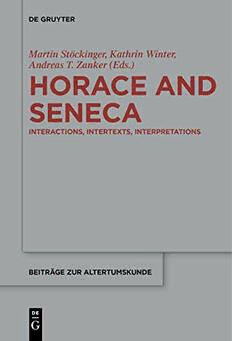Table Of ContentHorace and Seneca
Beiträge zur Altertumskunde
Herausgegeben von Susanne Daub, Michael Erler,
Dorothee Gall, Ludwig Koenen und Clemens Zintzen
Band 365
Horace
and Seneca
Interactions, Intertexts, Interpretations
Herausgegeben von
Martin Stöckinger, Kathrin Winter
und Andreas T. Zanker
ISBN 978-3-11-052402-4
e-ISBN (PDF) 978-3-11-052889-3
e-ISBN (EPUB) 978-3-11-052861-9
ISSN 1616-0452
Library of Congress Cataloging-in-Publication Data
A CIP catalog record for this book has been applied for at the Library of Congress.
Bibliografische Information der Deutschen Nationalbibliothek
Die Deutsche Nationalbibliothek verzeichnet diese Publikation in der Deutschen
Nationalbibliografie; detaillierte bibliografische Daten sind im Internet über
http://dnb.dnb.de abrufbar.
© 2017 Walter de Gruyter GmbH, Berlin/Boston
Druck und Bindung: Hubert & Co. GmbH & Co. KG, Göttingen
♾ Gedruckt auf säurefreiem Papier
Printed in Germany
www.degruyter.com
Foreword
Thisvolumeisbasedon aconferenceheld in the Seminarfür Klassische Philo-
logieat the Universityof Heidelberg in Julyof 2015. In its productionwe would
liketoregisteroursincerestthankstotheAlexandervonHumboldtStiftungand
Amherst College, as well as to the Mommsen Gesellschaft, for their generous
funding. We would also like to thank Jürgen Paul Schwindt and Gerrit Kloss
fortheirsupportoftheproject,aswellastheadministratorsandstudenthelpers
whomadetheconferenceitselfrunsosmoothly.Thetypescriptwaseditedwith
aplomb by Eugenia Lao.
Wewouldliketodedicatethevolumeinthenameofallofitscontributorsto
thememoryofourkeynotespeaker,JohnMoles,who,withhiscustomarygener-
osity and enthusiasm, contributed greatly to the original gathering. Only two
months after we met in Heidelberg we were deeply saddened to hear that he
hadpassedaway.Thethreeeditorsofthepresentvolumestillremember,andal-
wayswill,ourwalkwithJohnacrossHeidelberg’sAlteBrückeovertheNeckaron
the late-summer afternoon before the conference began.
Notesconcerningthetextsandtranslationsemployedareprovidedinthein-
dividualcontributions.Abbreviationsofnamesandtitlesfollowtheconventions
of the LSJ and OLD. Latin titles,when cited in full, are generally printed in the
original, save for Horace’s Odes, Epodes, Satires, and Epistles,whose frequency
in thescholarship,wefeel,overrides our aspirations to uniformity (this also al-
lows Seneca’s Epistulae Morales to be more clearlydifferentiated from Horace’s
Epistles).
Martin Stöckinger, Kathrin Winter, Andreas T. Zanker
Table of Contents
Introduction 1
I Philosophy in Literature – Literature in Philosophy
Barbara Del Giovane
Dressing Philosophy with sal niger. Horace’s Role in Seneca’s Approach to
the Diatribic Tradition 27
Francesca Romana Berno
Nurses’ Prayers, Philosophical otium, and Fat Pigs: Seneca Ep. 60 versus
Horace Ep. 1.4 53
Catharine Edwards
Saturnalian Exchanges: Seneca, Horace, and Satiric Advice 73
II Horatian Verse in Senecan Tragedy
Richard Tarrant
Custode rerum Caesare: Horatian Civic Engagement and the Senecan Tragic
Chorus 93
Christopher Trinacty
Horatian Contexts in Senecan Tragedy 113
Tobias Allendorf
Sounds and Space. Seneca’s Horatian Lyrics 137
Jonathan Geiger
Strictness, Freedom, and Experimentation in Horatian and Senecan
Metrics 159
VIII TableofContents
III Themes and Concepts
Gregor Vogt-Spira
Time in Horace and Seneca 185
Barak Blum
Studiorum instrumenta: Loaded Libraries in Seneca and Horace 211
Elena Giusti
The Metapoetics of Liber-ty. Horace’s Bacchic Ship in Seneca’s De
Tranquillitate Animi 239
Alexander Kirichenko
Constructing Oneself in Horace and Seneca 265
IV Modes of Quotation and Issues of Reception
Ute Tischer
Nostrafaciamus. Quoting in Horace and Seneca 289
Nina Mindt
Horace, Seneca, and Martial: ‘Sententious Style’ across Genres 315
Victoria Moul
Seneca, Horace, and the Anglo-Latin ‘Moralising Lyric’ in Early Modern
England 345
Table of Correspondences 371
Works cited 401
Contributors and Editors 431
General Index 433
Introduction
Thepairingoftwoauthorsmayappearbothold-fashionedandarbitraryintwen-
ty-firstcenturyclassicalstudies:thecomparisonofHomerandVirgil,Pindarand
Horace,SallustandTacitus,andVirgilandLucanhasprovidedtopicsfornumer-
ousbooks,articles,andchaptersoverthedecades.Theabundanceofsuchstud-
ies has in part been balanced by the changingscholarly modes of dealingwith
theliteraryrelationshipsinvolved–termssuchasimitatioandaemulatio,‘influ-
ence,’ ‘anxiety of influence,’ ‘allusion,’ ‘reference,’ ‘intertextuality,’ ‘tradition,’
‘dynamics of genre,’ and ‘reception,’ to give but a few examples, each come
withtheirownemphasesandframingsoftheconnectionsbetweentextsandau-
thors.Butwhyaddanotherpairingtothisvastbodyofscholarship?Andwhythe
particular pairing of Horace and Seneca?¹ A preliminary, and somewhat blunt,
answer is that to the best of our knowledge no one has undertaken it before,
at least not with due consideration to the entire oeuvres of both authors.
Several studies from the nineteenth and early twentieth century address or
touch on Horace and Seneca in tandem, often as part of an investigation of an
author-specifictopicsuch as‘Seneca’stechnique ofimitation’or‘tropesinSen-
ecan tragedy’: by wayof example we might note Zingerle (1873),Gaheis (1895),
Kapnukajas (1930), and Keseling (1941).Twoscholars of this period focused ex-
clusively on the relationship between Seneca’s tragedies and Horace’s Odes –
Gerber (1883),who explored Seneca’s use of Horatian metre, and Spika (1890),
who listed verbal parallels and imagery common to both Horace’s Odes and
the choral odes of Seneca. Although these studies still offer much useful mate-
rial,their methodology is of course dated. In more recent decades,we find two
brief overviews by Mazzoli (1974 and 1998) and an influential essay by Berthet
(1979),inadditiontoanumberofarticlesdevotedtospecificproblemsandtop-
ics by other scholars.² Important observations concerning the relationship of
HoraceandSenecahavebeenmadebyTarrantinhiscommentariesontheAga-
memnon(1976)andtheThyestes(1985),aswellasinaseriesofarticles,suchas
thoseonSeneca(2006)andthereceptionofHorace(2007).Whatisstillrequired,
OnemightcomparetherecentvolumeofBerlincourt/GalliMitić/Nelis2016,whosetitle,
LucanandClaudian,revealsthesametraitsasHoraceandSeneca.Intheirintroduction,theed-
itorsnotethatthesimilaritytotraditionalstudiesoftheaforementionedvarietyisintended,yet
clearlystatetheiraimnottoneglectmorerecenttheoreticalpointsandmethodologies.Cf.Ber-
lincourt/GalliMitić/Nelis2016,2–4.
E.g.Dionigi1980;Degl’InnocentiPierini1992and2013;Blänsdorf1998;Stevens1999;Schöps-
dau2015;Littlewood2016.
DOI10.1515/9783110528893-001
2 Introduction
however,isacomprehensivestudyoftherelationshipoftheHoratiancorpusto
Seneca’s philosophical and poetic works, one that takes into account modern
critical theory and methodologies. First steps in this direction have recently
beentakenbyTrinacty(2014),withafocusonHorace’sRomanOdes,andbyRi-
mell(2015a,82–147),whosestudyoftheconceptofenclosedspaceincludesan
analysis of the Horatian angulus and its reception in Seneca’s prose.
But beyondthis needtofill agapin the scholarship,thestudyof theinter-
playbetweenthesetwoauthorsisattractiveforavarietyofotherreasons.Horace
andSenecareveal,forexample,inmanyrespectsstrikingsimilarities,butareat
thesametimeparadoxicallydissimilarpreciselyatthesepointsofcontact.Both
authorswritephilosophyinaliteraryframeworkandtherebyengagecontinually
withthesamethemesandquestions–forexampletheideaofthegoodlife,the
properuseoftime,theformationoftheself,thedesideratumofmoderation–yet
do so from different philosophical angles (namely quasi-Epicureanism and
Roman Stoicism). Both have been criticised for their proximity to political
power,yetthisproximitytakesadifferentformineachcase–Horaceslowlyap-
proaching the centre of power from great distance, Seneca swiftly distancing
himselffromhispositionofgreatintimacywithNero’scourt.Bothworkinava-
rietyof differentgenres in the course of their longcareers,which, although the
precise genresdiverge greatly,constituteanalogous forms: philosophical letters
(whether in poetic sermo or in prose),dialogue (as can already be noted in the
authors’useofthetermssermoanddialogusasdescriptorsforindividualworks),
theinfluenceofdiatribeandsatire(housedincompletelydifferentgenres),and
of course lyric – and hereSeneca’s choral songswouldbe unthinkable without
Horace’sOdes,eveniftheyexistinadifferentcontextandserveadifferentend.
Finally,we might mention the similarities when it comes to the authors’ ironic
style, together with the formal correspondences – even down to the minora –
whichmakethecaseforadeepunderlyingconnectionbetweenthetwoauthors
allthemorecompelling.Noneoftheseitemsispreciselyreplicated,andyetthe
similarity is too clear to be denied.
Even from a superficial syncrisis such as that just outlined one recognises
thefundamentalandperhapsuniquecharacteroftherelationshipbetweenHor-
aceand Seneca:itconsistsin similarity rather than uniformity.The corporaare
ofcourseextremelydifferent,yetwhenset next toeach other they revealthem-
selves to be interlaced with non-systematic parallels and congruencies in their
composition, their workmanship, and in numerous details (although never in
their entirety).The relationship has the appearance of being both intimate and
distanced. It is precisely in this that the fascination of the theme ‘Horace and
Seneca’lies,aswellasitsgreatdifficulty:sweepingattemptstodescribethere-
lationshipexhaustivelyortoprovideanunderlyingaxiomforitsanalysisgener-

